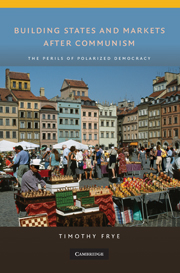Book contents
- Frontmatter
- Contents
- List of Tables and Figures
- Acknowledgments
- Introduction
- 1 The Political Logic of Economic and Institutional Reform
- 2 Political Polarization and Economic Inequality
- 3 The Pace and Consistency of Reform
- 4 Political Polarization and Economic Growth
- 5 Political Polarization and Policy Instability: The View from the Firm
- 6 Nationalism and Endogenous Polarization
- 7 Russia: Polarization, Autocracy, and Reform
- 8 Bulgaria: Polarization, Democracy, and Reform
- 9 Poland: Robust Democracy and Rapid Reform
- 10 Uzbekistan: Autocracy and Inconsistent Gradualism
- 11 Conclusion
- References
- Index
- Titles in the series
- References
References
Published online by Cambridge University Press: 05 June 2012
- Frontmatter
- Contents
- List of Tables and Figures
- Acknowledgments
- Introduction
- 1 The Political Logic of Economic and Institutional Reform
- 2 Political Polarization and Economic Inequality
- 3 The Pace and Consistency of Reform
- 4 Political Polarization and Economic Growth
- 5 Political Polarization and Policy Instability: The View from the Firm
- 6 Nationalism and Endogenous Polarization
- 7 Russia: Polarization, Autocracy, and Reform
- 8 Bulgaria: Polarization, Democracy, and Reform
- 9 Poland: Robust Democracy and Rapid Reform
- 10 Uzbekistan: Autocracy and Inconsistent Gradualism
- 11 Conclusion
- References
- Index
- Titles in the series
- References
- Type
- Chapter
- Information
- Building States and Markets after CommunismThe Perils of Polarized Democracy, pp. 255 - 282Publisher: Cambridge University PressPrint publication year: 2010

